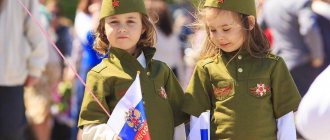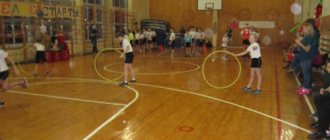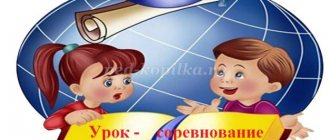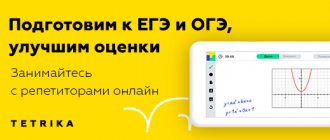Presentation based on A. Gaidar’s story “Timur and his team”
Slide 1
A presentation for the interregional competition “The Sciences Nourish Youths” was prepared by a student of grade 10b, Municipal Educational Institution “Secondary School No. 2, Bazarny Karabulak, Saratov Region.” A presentation for the interregional competition “The Sciences Nourish Youths” was prepared by Firstov Vitaly, a student of the 10th “b” grade of Municipal Educational Institution “Secondary School No. 2 r.p. Bazarny Karabulak" Head: Grigorieva E.V. The story of A.P. Gaidar “Timur and his team” is the hero of the year 2011 Interregional competition “Science feeds youth” 01/17/2012
Slide 2
A.P. Gaidar “Timur and his team” Interregional competition “Science feeds youth” 01/17/2012
Slide 3
“You always thought about people, and they will repay you in kind” Interregional competition “Sciences nourish young people” 01/17/2012
Slide 4
Arkady Petrovich Gaidar Arkady Petrovich Gaidar Famous Soviet children's writer, participant in the Civil and Great Patriotic Wars. Real name - Arkady Petrovich Golikov Date of birth: January 9 (22), 1904 Place of birth: city of Lgov, Kursk province, Russian Empire Date of death: October 26, 1941 (37 years old) Place of death: near the village of Leplyaevo, Kanevsky district, Cherkasy region Awards : Order of the Patriotic War, 1st degree, Order “Badge of Honor” Interregional competition “Sciences nourish youth” 01/17/2012
Slide 5
First publication September 5, 1940 newspaper “Pionerskaya Pravda” Interregional competition “Sciences nourish youth” 01/17/2012
Slide 6
The significance of the work In Soviet times, Gaidar's books were one of the main means of educating the younger generation. The educational authorities of the USSR set the heroes of his novels and short stories as examples for Soviet children. The groups of children organized by Soviet schools to help the elderly were called “Timurovskys”, and their participants were called “Timurovtsy”, in honor of the main character of Gaidar’s story “Timur and His Team”. Interregional competition “Science feeds youth” 01/17/2012
Slide 7
Who are the “Timurovites”? After the publication of the book about Timur, the concept of a “Timurite,” a pioneer helping people, spread widely throughout the USSR. Later, when “Timurov’s” work among the masses became not voluntary, but imposed by the school and the pioneer organization, this concept acquired a sarcastic meaning among Soviet schoolchildren. Interregional competition “Science feeds youth” 01/17/2012
Slide 8
How the Timurites were born. The prototype of the “Timurites” were the scouts (who also painted stars on the houses of the families of the fallen St. George Knights of the First World War as a sign of their patronage), as well as the children of Orthodox priests, who dressed in a similar way with the scouts and Timurites - in T-shirts and shorts. The first Timurov detachments were created in the city of Klin, Moscow Region. In the city where Arkady Petrovich Gaidar wrote his story “Timur and His Team.” Interregional competition “Science feeds youth” 01/17/2012
Slide 9
Timurovites are never former! The first Timurov team was founded at school No. 2 in 1940 (now MOU-Gymnasium No. 2). It consisted of 6 Timurovites. Afterwards, in 1982, when school No. 2 moved to a new building (where it is still located), the Timurov headquarters “Red Horseman” was founded (headed by N. I. Zakharova). After perestroika, Nina Ivanovna Zakharova, the head of the “Red Horseman” and the school administration decided to continue the Timurov work of the old headquarters and founded the Timurov headquarters “Danko”, which still exists. Interregional competition “Science feeds youth” 01/17/2012
Slide 10
Interregional competition “Science feeds youth” 01/17/2012
Slide 11
At the Danko headquarters, operations such as “Veteran is always nearby”, “Let’s collect waste paper”, “Young Soldier” and many others are carried out. The Danko headquarters is a headquarters leader and an example of other children's organizations. The motto of the Danko headquarters is: “We give our hearts to people.” Interregional competition “Science feeds youth” 01/17/2012
Slide 12
Continuation of the story In the same year, Gaidar wrote a sequel to “Timur...” - the story “The Commandant of the Snow Fortress.” In the first days of the Great Patriotic War, Gaidar wrote the film script “Timur’s Oath,” which completed a kind of trilogy. Interregional competition “Science feeds youth” 01/17/2012
Slide 13
Interesting facts In the early edition of Duncan and His Team, the hero is Vovka Duncan. The influence of the work of Jules Verne is obvious: the yacht "Duncan" at the first alarm signal went to the aid of Captain Grant. The heads of the film studio demanded that the hero be renamed, and then Gaidar gave the hero the name of his own son, whom he called “little commander” in life. Interregional competition “Science feeds youth” 01/17/2012
Slide 14
Image of Timur Timur is a social hero, a pioneer, his symbolic sign is a red tie. The image of Timur embodies the ideal type of a teenage leader with his desire for noble deeds, secrets, and pure ideals. Timur unites a group of peers around him in a dacha village and unselfishly helps old people, children - those who, due to their defenselessness, are usually victims of the mischief of teenagers. The image of Timur embodies the best features of a pioneer who grew up in a new, socialist country. Interregional competition “Science feeds youth” 01/17/2012
Slide 15
Interregional competition “Science feeds youth” 01/17/2012 Timur is the main character of the story
Slide 16
The image of Zhenya The image of Zhenya is one of the central ones in the story. With each new scene, the character of a playful, enthusiastic girl who grew up without a mother, yearning for parental affection, emerges more and more clearly. The older sister loves her, but assumes excessive severity and “maturity”, does not want to understand small but important secrets for Zhenya, gets angry at her “always ridiculous jokes”, and is reluctant to answer questions that are naive and unnecessary, as it seems to her. Gaidar gives readers the opportunity to penetrate into the essence of the relationship between the sisters: Olga takes care of Zhenya, but considers it necessary to teach her, and does not feel that she is offending her sister with her mistrust. Interregional competition “Science feeds youth” 01/17/2012
Slide 17
Interregional competition “Science nourishes young people” Zhenya is one of the main characters of the story “Timur and his team” 01/17/2012
Slide 18
The image of Kvakin Mishka Kvakin, although he is the main hooligan of the town, evokes sympathy and is a very interesting person with a complex character. In addition, he has pronounced leadership qualities. He often does bad things and comes into conflict with Timur, not because he approves of the actions of his gang, but because he is unwilling to agree with his rival on anything. Interregional competition “Science feeds youth” 01/17/2012
Slide 19
Interregional competition “Science nourishes young people” Kvakin is an interesting personality with a complex character 01/17/2012
Slide 20
Kvakin is brave and not afraid of Timur, who commands a much larger number of guys and has the support of the existing system. In a fight with a strong man, Geikoy does not hesitate. Although Kvakin despises many of his “subordinates,” nevertheless, he does not abandon them in trouble and is ready to answer for his actions. Mishka Kvakin is humane in his own way. He is disgusted by his assistant Figure, who has no conscience. When Timur is having a hard time, Kvakin does not touch him. He values and respects his opponent. Interregional competition “Science feeds youth” 01/17/2012
Slide 21
Film adaptations of the story became the basis for films of the same name in 1940 and 1976. Interregional competition “Science feeds youth” 01/17/2012
Slide 22
In January 1941, the film “Timur and His Team” directed by A.E. Razumovsky was released. In 1976, another film version was created at the Odessa Film Studio. There are several performances for professional and amateur theaters. The film “Timur's Oath” was filmed by director L. Kuleshov in 1941, but did not make it to the screen. Interregional competition “Science feeds youth” 01/17/2012
Slide 23
A youth movement of “Mercy” detachments is developing in our region. This youth movement, aimed at providing assistance to the elderly and disabled, has been actively developing since 2001. “Mercy” units have been created and operate at social service centers for the region’s population. About two thousand teenagers in 35 districts of the region provide assistance to those who need it. Representatives of the “Mercy” teams work weeding beds, repairing fences, collecting vegetables, and clearing snow from paths in the yards of elderly citizens and disabled people in winter. Interregional competition “Science feeds youth” 01/17/2012
Slide 24
List of literature and Internet resources Gaidar A. Stories - Saratov: Volga Book Publishing House, 1979 Wikipedia - Free Encyclopedia Piplz.ru Interregional competition “Sciences nourish youth” 01/17/2012
Slide 25
Helping a veteran Interregional competition “Science feeds youth” 01/17/2012
Slide 26
7th regional rally of “Mercy” detachments Interregional competition “Sciences nourish youth” 01/17/2012
Slide 27
Thank you for your attention! Interregional competition “Science feeds youth” 01/17/2012
Literary reading lesson notes by A.P. Gaidar “Timur and his team.”
Arkady Petrovich Gaidar (Golikov) was born in 1904 in the city of Lvov.His father, a school teacher, Pyotr Isidorovich Golikov, was from a peasant background. Mother - Natalya Arkadyevna Salkova, was a noblewoman of a not very noble family, first worked as a teacher, later as a paramedic.
When Arkady was eight years old, the Golikovs moved to the city of Arzamas. The writer spent his childhood and youth here.
Arkady's childhood, with his usual boyish activities - real school, games, first poems, "sea battles" on the pond - coincided with the First World War and the revolution.
At the age of fourteen, Gaidar joined the Red Army. He fought on many fronts, and in the intervals between battles he studied at the Kyiv command courses, then at the Higher Rifle School and at the age of seventeen he commanded a regiment.
In 1919, after completing the course, A. Gaidar received the title of “red commander”; at the age of 15 he commanded a company, and at the age of 17, a regiment. A. Gaidar fought on many fronts of the civil war, was repeatedly wounded, and suffered from typhus. In 1924, due to health reasons, he was forced to leave the army. He became a writer and journalist.
Almost all of A. Gaidar’s works are intended for children, from the first story to his last works: “Timur and His Team” (1940) and “Hot Stone” (1941).
From the very beginning of the Great Patriotic War, A. Gaidar began to persistently strive to return to the army. In 1941 he volunteered for the front, as a correspondent for Komsomolskaya Pravda.
He remained in Ukraine, temporarily captured by the Nazis, and fought in a partisan detachment. On the night of October 26, 1941, a group of partisans was returning from a mission. While crossing the railway tracks we came across Germans. A. Gaidar was the first to notice them. “Guys, Germans!” - he managed to shout to his comrades and died a heroic death in an unequal battle with the Nazis, saving his comrades.
Arkady Gaidar died at the age of 37. He died the death that, if he could choose, he would have chosen. In a battle with enemies, he was cut down by a machine gun burst, defending what he believed in, without loud words or solemn speeches, simply giving himself everything for which he lived and what he believed in - the happiness of his people.
He was posthumously awarded the Order of the Patriotic War, 1st degree. Gaidar began his life as a soldier and died as a soldier.
— It should be noted that each book contains personal observation, personal experience, personal experience of the author.
And you can guess for yourself which work we will talk about today.
Make a sentence from the given words. This will be the title of the work.
Today we will begin our acquaintance with A. Gaidar’s story “Timur and his team.” Look at the drawing on page 134. Can you guess from it what the story will be about?
Who read the story? Would you advise the other guys to read it in full?
The story “Timur and His Team” immediately aroused unusual interest among the young reader and to this day is one of the most beloved works of children.
— What does the word “team” mean?
And in Ozhegov’s dictionary, the word team means a group of people connected by something, someone’s entourage.
Vocabulary work:
Gentleman, castor oil, thrush, tub, row, engineer, rotten (staircase), habitable, mossy (roof), steering wheel, searchlight, maneuvering, squadron, division.
Timur and his team
Read: Timur and his team.PDF (0.60 Mb)
It is a rare case that a story of the same name was later written based on a film, and not vice versa. Arkady Gaidar created a script that he did not plan to give book life to, but the screen success of “Timur and His Team” forced the writer to put the adventures of Timur’s men in hardcover. The main characters - pioneers Timur and Zhenya - got the names of the author's son from his first marriage and his adopted daughter from his second.
Director Alexander Razumny did not make children's films until 1940; he was a master of films about the revolution, war and the difficult fate of the Soviet military. With his usual dramatic colors, he was able to paint a cheerful, seemingly childish story about the adventures of schoolchildren helping the elderly, children, and especially the families of those whose relatives serve in the Red Army. Filming took place in Samara and Nakhabino near Moscow.
Still from the film. Photo: kino-teatr.ru
Still from the film. Photo: kino-teatr.ru
Still from the film. Photo: kino-teatr.ru
Komsomol member Olga (Marina Kovaleva), together with her younger sister Zhenya (Katya Derevshchikova), comes for the summer to a dacha near Moscow, where Timur launched a vigorous social activity. Olya forbids her restless sister to communicate with the team, which only the lazy ones in the village have not heard of. But the guys in red ties turn out to be not hooligans, but saviors. This becomes clear only at the end of the film, when Timur, under pain of expulsion from school, steals a motorcycle and takes Zhenya to Moscow so that she can accompany her father to the front.
Timur performs the main feat in the film on the L-300, the first Soviet production motorcycle. While driving the same vehicle, Timur, being a fictional character, in real life deprived Arkady Gaidar of an honorary state award. The writer inappropriately commented on the episode where the main characters enter Moscow on a motorcycle, let a column of Budenovites pass in front of them and stop in front of the monument to Stalin. “I don’t want to look like a sycophant,” - that’s exactly how, without mincing words, Gaidar demanded that this scene, 1 minute 50 seconds long, be cut out. “At the top” they pretended that they did not notice the antics of the respected writer, but later, instead of a prestigious state award, the author received only the ordinary Order of the Badge of Honor.
The main character of the film did not receive a single award, except for all-Union recognition. Boris Runge, Yuri Yakovlev and even the son of Arkady Gaidar, Timur, auditioned for the role of Timur, played by the son of the famous poet Stepan Shchipachev, Liviy Shchipachev.
Shchipachev Jr. starred in only two films: “Timur and His Team” and “Timur’s Dream.” The film was shot by Alexander Razumny in a directorial duet with Lev Kuleshov in 1942 as a continuation of the adventures of Timurov’s men. After this, Livy, who was predicted to have a brilliant future as an actor, did not connect his life with cinema. He graduated from the Surikov Institute in painting. He was as active as his hero, a member of the Union of Artists of the USSR, and his works regularly graced the best exhibitions in the country.
In 1965, the film was restored and slightly re-edited at the film studio. Gorky, and first of all they excluded the scene with the monument to the leader.





